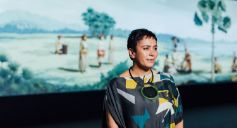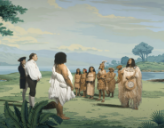Transcending the Traditional Narrative
Nominated to represent New Zealand at the 2017 Venice Biennale, one of the most prestigious art festivals in the world, In Pursuit of Venus [infected] can be seen as the response to the story told in Les Sauvages de la Mer Pacifique. Maōri artist Lisa Reihana reimagined its depiction into a “panoramic pantomime”, a video installation inspired by the original work. In this installation, instead of a voyeuristic point of view from which the viewer can observe the Pacific Indigenous subjects, she depicts interactions between the European colonists and the Pacific Indigenous people. She invited actors from different Pacific Indigenous backgrounds to participate and recorded dialogues in different Indigenous languages as background noise. By bringing life, diversity but also accuracy to the depictions, she is able to explore and emphasize the complexity of issues concerning identity, gender, and colonial and racial violence. This way, she rejects the monolithic misrepresentation of Indigenous people that has been present for a very long time.
By taking and maintaining agency over the gaze and representation, she not only deviates from the colonial imagination of the past five hundred years that has molded Indigenous bodies into pleasing, noble, and exoticized positions, she also takes back self-determination and sovereignty. In her own words:
By being [in the installation] as living, breathing people, we’re not a dying race. We are survivors. We are the embodiments of our ancestors and the philosophies and ideas that flourished from that time.[Cf]
Thus, through her artwork she reshapes the narrative surrounding Pacific Indigenous people, thereby transcending the traditional narrative.


![The three dancing women as depicted by Lisa Reihana in "In pursuit of Venus [infected]"](https://micrio.thingsthattalk.net/dCkGc/views/max/132x128.png)